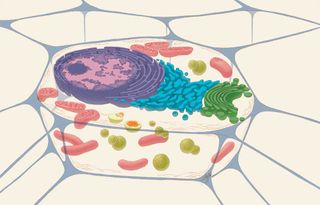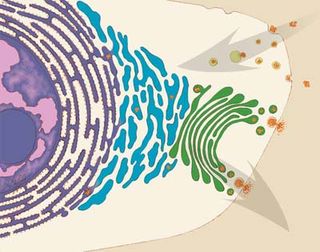The Amazing World Inside a Human Cell

As you read these words, electricity is zinging through your brain, voracious killers are coursing through your veins and corrosive chemicals bubble from your head to your toes. In fact, your entire body is like an electrical company, chemical factory, transportation grid, communications network, detoxification facility, hospital and battlefield all rolled into one. The workers that drive these activities are your cells.
Our bodies contain trillions of cells, organized into more than 200 major types. At any given time, each cell is doing thousands of routine jobs, like creating and using energy, manufacturing proteins and responding to environmental cues. Different cell types also have special duties, like building skin or bone, pumping out hormones or making antibodies.
Let's take a quick trip inside to see how cells carry out their major tasks.

Imagine you’ve shrunk down to 3 millionths of your normal size and are now about 0.5 micrometers tall—way smaller than a dust mite or the width of a hair strand. At this scale, a medium-sized human cell looks as big as a football field.
Nucleus
From your new perspective, the cell's somewhat spherical nucleus catches your attention. It looks about 50 feet wide. Occupying up to 10 percent of the cell's interior, the nucleus is the most prominent organelle, or cellular compartment. It contains the cell's genetic material, DNA, which guides the making of billions of protein molecules that participate in nearly every cellular process.
Membranes
Sign up for the Live Science daily newsletter now
Get the world’s most fascinating discoveries delivered straight to your inbox.

Encasing the cell is a membrane with special gates, channels and pumps that let in or force out selected molecules. The membrane protects the cell's internal environment—a thick brew called the cytosol made of salts, nutrients and proteins that accounts for about half the cell's volume (organelles make up the rest). In addition to the outer membrane, which is made up of proteins and lipids (fats), the cells of humans and other higher organisms have a pair of porous membranes that envelop the nucleus. Each organelle also has an outer membrane.
Endoplasmic Reticulum and Partners
Next to the nucleus are enormous, interconnected sacs called the endoplasmic reticulum or ER. From your shrunken view, each sac is only a few inches across, but they can extend to lengths of 100 feet or more. The sacs come in two types: a "rough" version covered with protein-making ribosomes and a "smooth" version that makes lipids and breaks down toxic molecules.
The ER sends newly made proteins and lipids to the Golgi complex, a short and narrow structure inside the cytosol. The Golgi complex processes them and sends the molecules to their final destinations inside or outside the cell.
Mitochondria

About the size of pickup trucks from where you're floating, the organelles called mitochondria convert energy from your food into adenosine triphosphate, or ATP, to power biochemical reactions. A typical cell burns through 1 billion molecules of ATP every 1 to 2 minutes.
Like all other organelles, mitochondria are enclosed in an outer membrane. But they also have an inner membrane that's actually four or five times larger than the outer one. The inner membrane doubles over in many places so it can fit, extending long, fingerlike folds into the center of the organelle. These folds vastly increase the surface area for ATP production.
40,000-Foot View
Back in the human-sized world, many scientists funded by the National Institutes of Health are studying these cellular structures—and many others not listed here—because knowledge about them underpins our understanding of health and disease. For instance, recent research suggests why the nucleolinus (a cellular compartment found in a range of species) is crucial for proper cell division, and how a special arrangement of microtubules (cellular highways that transport raw materials) may help nerve cells rebuild after injury.
Learn more:
This Inside Life Science article was provided to LiveScience in cooperation with the National Institute of General Medical Sciences, part of the National Institutes of Health.
Most Popular




